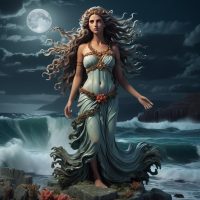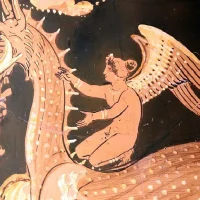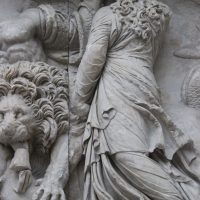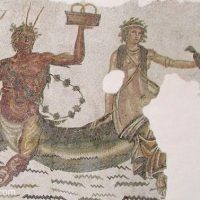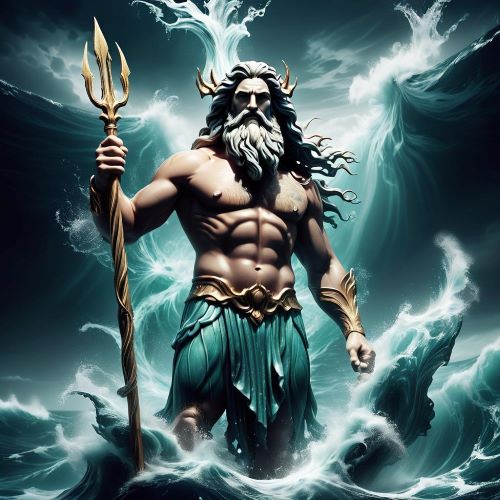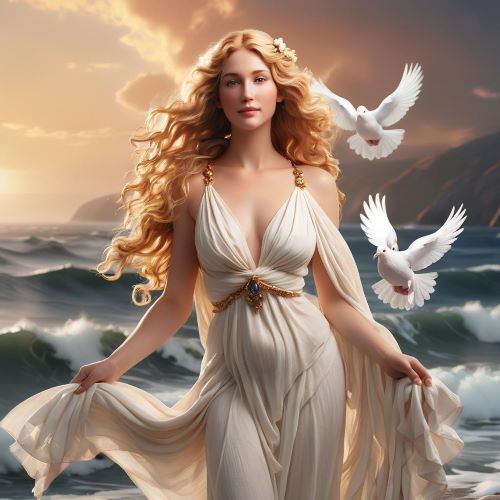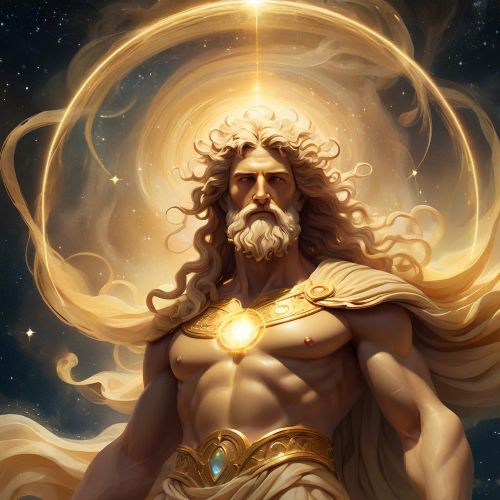Ceto : Primordial Sea Goddess
Listen
At a glance
| Description | |
|---|---|
| Origin | Greek Mythology |
| Classification | Gods |
| Family Members | Gaia (Mother), Pontus (Father), Nereus, Thaumas, Eurybia, Phorcys (Siblings), Graeae, Gorgons, Ladon (Children) |
| Region | Greece |
| Associated With | Sea, Creation |
Ceto
Introduction
In Greek mythology, Ceto (also spelled Keto, Κητώ) is a primordial sea goddess associated with the perils of the ocean and the monstrous creatures that dwell within its depths. She belongs to the earliest generation of deities, born of Gaia (Earth) and Pontus (Sea), making her an elemental force rather than a personalized Olympian. Unlike Poseidon, who governs the seas as a domain of power, or Nereus, who embodies its gentler qualities, Ceto represents the dark unknown beneath the waves. She is remembered as the mother of some of the most terrifying figures in mythology, including the Gorgons, the Graeae, and Echidna. Ceto’s role highlights the Greeks’ perception of the sea as both life-giving and treacherous, a place of hidden beauty and lurking danger.
Physical Traits
Descriptions of Ceto are rare, and she is more often defined by her terrifying children than by her own features. Hesiod, in his Theogony, calls her “fair-cheeked,” suggesting a paradoxical element of beauty. However, her name itself derives from kētos, meaning “sea monster” or “whale,” emphasizing her connection with monstrous beings rather than divine elegance. Later artistic and literary traditions sometimes depict her with serpentine traits or surrounded by aquatic horrors, reflecting her dominion over the uncanny and unpredictable sea. In Hellenistic art, figures linked to Ceto were often shown with grotesque or hybrid features, blending human and animal traits. This ambiguity allows her to exist as both a goddess and a personification of primal terror, embodying the dual character of the ocean—majestic yet lethal.
Family
Ceto’s family places her at the heart of Greek cosmogony. As the daughter of Gaia and Pontus, she belongs to the primordial deities who predate the Olympian order. Her siblings include Nereus, Thaumas, Eurybia, and Phorcys. With Phorcys—her brother and consort—she gave birth to a brood that shaped much of Greek myth. Their children included the Graeae, three aged sisters who shared one eye and one tooth; the Gorgons, hideous winged beings crowned with snakes, among them the famous Medusa; Echidna, the half-woman, half-serpent “mother of monsters”; and Ladon, the serpent guardian of the golden apples in the Garden of the Hesperides. Some traditions also credit Ceto with being the mother of the Hesperides themselves. Through this lineage, she became the matriarch of many monsters later confronted by heroes such as Perseus and Heracles. The family of Ceto illustrates the Greek tendency to explain natural and cosmic dangers through genealogies of gods and monsters.
Other Names
Ceto appears in ancient texts under a variety of names and epithets, reflecting different regional and literary traditions. She is sometimes called Crataeis, meaning “the Mighty,” particularly when identified as the mother of Scylla, the monstrous guardian of the Strait of Messina. In some accounts, she bears the epithet Trienos, loosely translated as “of the three years,” though the exact meaning remains obscure. Her name also evolved linguistically into Latin as cetus, giving rise to modern scientific terms such as “cetacean,” referring to whales and dolphins. These varying names highlight her multifaceted identity: at once a goddess, a mother of horrors, and a linguistic root for the vast creatures of the sea. In later periods, her associations were sometimes merged with other liminal goddesses such as Hecate, further underscoring her link with mystery and fear.
Powers and Abilities
Ceto’s significance lies less in direct mythological action and more in what she represents. As a primordial goddess, she personifies the monstrous and chaotic aspects of the sea. Her greatest power is generative—she produces offspring that embody different forms of danger. The Graeae symbolize decay and old age, the Gorgons represent petrifying terror, and Echidna encapsulates the hybrid monstrosities that heroes must face. Through them, Ceto exerts an indirect but pervasive influence on mythological narratives. She embodies the ocean as a liminal space: a barrier between worlds, a source of both nourishment and death. While not portrayed as a combative deity, her presence resonates in the fear of the unknown, storms, shipwrecks, and the creatures that sailors imagined lurking beneath the surface. Ceto’s essence is the eternal unpredictability of the deep sea, a power more psychological than physical, instilling awe and dread in equal measure.
Modern Day Influences
The legacy of Ceto has endured far beyond the pages of Hesiod and the fragments of lost Greek myths. Her name directly influenced scientific terminology: the word “cetology,” the study of whales and marine mammals, stems from her. In literature and popular culture, Ceto’s archetype appears in depictions of sea monsters, mermaids, and sea witches. Writers such as Rick Riordan have reimagined her in modern fantasy, where her monstrous heritage continues to inspire. Visual artists often reinterpret her as a fusion of grace and horror, exploring themes of femininity, fear, and the sublime.
In environmental discourse, Ceto is sometimes invoked symbolically as a guardian of the ocean, representing both the fragility and power of marine ecosystems. Through eco-feminist interpretations, she has been cast as a figure of female primal energy—creative, destructive, and resistant to control. Astronomically, her influence persists in the naming of minor planet 65489 Ceto and its moon Phorcys, linking myth to celestial discovery. Even in video games and films, sea monsters rooted in Ceto’s mythological legacy remind audiences of the ocean’s dual nature: a realm of wonder and peril.
Related Images
Source
Theoi Greek Mythology. (n.d.). Ceto (Keto) – Greek goddess of sea monsters. Retrieved from https://www.theoi.com/Pontios/Keto.html
Wikipedia. (2025, September 10). Ceto. Retrieved from https://en.wikipedia.org/wiki/Ceto
Study.com. (2025, July 30). Ceto & Phorcys | Sea Monsters in Greek Mythology. Retrieved from https://study.com/learn/lesson/ceto-phorcys-greek-mythology-sea-monsters.html
Greek Gods & Goddesses. (2024, January 6). Ceto – Goddess of the Water – Facts and Information. Retrieved from https://greekgodsandgoddesses.net/goddesses/ceto-goddess-of-the-water/
Mythopedia. (2023, September 3). Ceto. Retrieved from https://mythopedia.com/topics/ceto/
Greek History Hub. (n.d.). The Complex Identity of Ceto in the World of Greek Mythology. Retrieved from https://www.greekhistoryhub.com/pages/the-complex-identity-of-ceto-in-the-world-of-greek-mythology-e1e2b9e3.php
History Cooperative. (n.d.). Ceto: The Goddess of Sea Monsters in Greek Mythology. Retrieved from https://historycooperative.org/ceto/
Greek Boston. (2019, March 11). All About Ceto the Sea Goddess in Greek Mythology. Retrieved from https://www.greekboston.com/culture/mythology/ceto-sea-goddess/
Hesiod. (8th century BCE). Theogony (lines 270–336). Translated by Hugh G. Evelyn-White.
Apollodorus. (1st century BCE). Library (1.2.6, 2.4.2ff). Translated by Sir James George Frazer.
Hyginus. (1st century CE). Fabulae. Preface 9.
Pliny the Elder. (77 CE). Natural History (5.14.69). Translated by H. Rackham.
Of One Tree. (n.d.). Ceto: Unveiling the Mysteries of the Greek Goddess. https://ofonetree.com/ceto-unveiling-the-mysteries-of-the-greek-goddess/
Pagan Club. (n.d.). Ceto: Primordial Greek Goddess and Mother of Monsters. https://www.paganclub.com/ceto-primordial-goddess-of-monsters/
Grimal, P. (1996). The Dictionary of Classical Mythology. Blackwell Publishing.
Frequently Asked Questions
What is lorem Ipsum?
I am text block. Click edit button to change this text. Lorem ipsum dolor sit amet, consectetur adipiscing elit. Ut elit tellus, luctus nec ullamcorper mattis, pulvinar dapibus leo.
What is lorem Ipsum?
I am text block. Click edit button to change this text. Lorem ipsum dolor sit amet, consectetur adipiscing elit. Ut elit tellus, luctus nec ullamcorper mattis, pulvinar dapibus leo.
What is lorem Ipsum?
I am text block. Click edit button to change this text. Lorem ipsum dolor sit amet, consectetur adipiscing elit. Ut elit tellus, luctus nec ullamcorper mattis, pulvinar dapibus leo.
What is lorem Ipsum?
I am text block. Click edit button to change this text. Lorem ipsum dolor sit amet, consectetur adipiscing elit. Ut elit tellus, luctus nec ullamcorper mattis, pulvinar dapibus leo.
What is lorem Ipsum?
I am text block. Click edit button to change this text. Lorem ipsum dolor sit amet, consectetur adipiscing elit. Ut elit tellus, luctus nec ullamcorper mattis, pulvinar dapibus leo.


